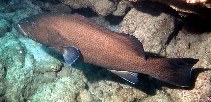| Family: |
Epinephelidae (Groupers) |
| Max. size: |
120 cm TL (male/unsexed) |
| Environment: |
demersal; marine; depth range 5 - 73 m |
| Distribution: |
Eastern Pacific: Isla del Coco off Costa Rica and Galapagos Islands (Ecuador). Reports from Panama and Peru have been discounted (Ref. 6873). |
| Diagnosis: |
Dorsal spines (total): 11-11; Dorsal soft rays (total): 16-17; Anal spines: 3-3; Anal soft rays: 11-11. Distinguished by the following characteristics: dark to olive-brown body color with purplish and lighter brown spots, or plain dark brown; xanthic morph is bright yellow all over; depth of body contained 2.9-3.2 times in SL; head length 2.6-2.9 times in SL; slightly convex interorbital area; angular preopercle, with serrate lobe at angle; posterior nostrils of adults much larger than anterior ones (Ref. 89707). |
| Biology: |
Found among rock walls, underwater lava ridges, and all kinds of well structured vertical rock formations (Ref. 11295). Juveniles found in shallow sandy lagoons (Ref. 5222), also in seagrass beds, mangrove lagoons, shallow lava reefs and inland lava ponds (Ref. 11295). Adults are mainly piscivorous, prey size increasing with predator size (Ref. 11295). |
| IUCN Red List Status: |
Endangered (EN); Date assessed: 15 September 2022 (A2bd) Ref. (130435)
|
| Threat to humans: |
harmless |
Source and more info: www.fishbase.org. For personal, classroom, and other internal use only. Not for publication.

